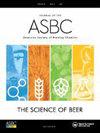北京地区第七轮酱味白酒发酵过程中微生物群落和挥发性物质的变化
IF 1.8
4区 农林科学
Q4 BIOTECHNOLOGY & APPLIED MICROBIOLOGY
Journal of the American Society of Brewing Chemists
Pub Date : 2023-10-02
DOI:10.1080/03610470.2023.2253704
引用次数: 0
摘要
摘要不同地区生产的酱香型白酒产品在风味特征上存在明显差异,但区域风味物质形成的原因尚不清楚。酱味白酒的酿造过程包括多次窖发酵。酒窖发酵结束后产生的底酒对酱味白酒产品的风味有重要影响。本研究考察了北京地区酱香型白酒在第7次圆坑发酵过程中微生物群落演替和风味成分的变化,并对比分析了与其他地区酱香型白酒在微生物群落组成和风味成分上的差异。结果表明,乳酸菌属、Virgibacillus属、Thauera属和Kroppenstedtia属为优势菌属,Byssochlamys属、Cutaneotrichosporon属和Apiotrichum属为优势真菌属。在发酵谷物中鉴定并定量鉴定了47种挥发性化合物。L(-)-乳酸乙酯、己酸乙酯和琥珀酸二乙酯的浓度随时间逐渐降低,而乙酸苯乙酯、棕榈酸乙酯和苯乙酸乙酯的浓度则增加。优势微生物的相对丰度和挥发性化合物的浓度随发酵时间的延长呈连续变化。乳酸菌、Virgibacillus和Kroppenstedtia与苯乙酸乙酯和苯乙醇的合成呈正相关,与己酸乙酯的合成呈负相关。微生物群落结构的差异是造成酱味白酒地域风味特征和轮次基础白酒风味差异的部分原因。本研究将对酱味白酒地域风味化合物的形成提供深入的见解。关键词:风味化合物变化微生物群落演替风味特征酱味白酒披露声明作者无相关利益冲突需披露作者对国家自然科学基金(No.31830069, No. 32001638)、北京市自然科学基金(No.31830069, No. 32001638)、北京市教委(No.31830069, No. 32001638)的支持表示衷心的感谢。KZ202110011016)。本文章由计算机程序翻译,如有差异,请以英文原文为准。
Changes in Microbial Communities and Volatile Compounds during the Seventh Round of Sauce-Flavor baijiu Fermentation in Beijing Region
AbstractSauce-flavor baijiu products produced in different regions have perceptible differences in flavor characteristics, but the reasons for the formation of regional flavor substances are still unclear. The brewing process of sauce-flavor baijiu includes multiple rounds of pit fermentation. The base baijiu produced at the end of pit fermentation contributes significantly to the flavor of sauce-flavor baijiu products. This study investigated the microbial community succession and changes in flavor compounds during 7th round pit fermentation of sauce-flavor baijiu produced in Beijing region and comparatively analyzed the componential differences in microbial community and flavor compounds with sauce-flavor baijiu produced in other regions. It was found that Lactobacillus, Virgibacillus, Thauera, and Kroppenstedtia were the dominant bacterial genera, and Byssochlamys, Cutaneotrichosporon, and Apiotrichum were the dominant fungal genera. A total of 47 volatile compounds were identified and quantified in fermented grains. The concentrations of ethyl L(-)-lactate, ethyl caproate, and diethyl succinate gradually decreased with time, while the concentrations of phenethyl acetate, ethyl palmitate, and ethyl phenylacetate increased. The relative abundance of dominant microorganisms as well as the concentrations of volatile compounds showed a successional pattern with fermentation time. Lactobacillus, Virgibacillus, and Kroppenstedtia were positively associated with the synthesis of ethyl phenylacetate and phenylethyl alcohol, while negatively associated with the synthesis of ethyl caproate. Differences in microbial community structure are partly responsible for the regional flavor characteristics of sauce-flavor baijiu and the flavor differences between rounds of base baijiu. This study will provide in-depth insights into the formation of regional flavor compounds of sauce-flavor baijiu.Keywords: Changes in flavor compoundsmicrobial community successionregional flavor characteristicssauce-flavor baijiu Disclosure statementThe authors have no relevant conflicts of interest to disclose.Additional informationFundingThe authors wish to express their deep gratitude and appreciation for the support obtained from the National Natural Science Foundation of China (No.31830069, No. 32001638), the Beijing Municipal Natural Science Foundation & Beijing Municipal Education Commission (No. KZ202110011016).
求助全文
通过发布文献求助,成功后即可免费获取论文全文。
去求助
来源期刊

Journal of the American Society of Brewing Chemists
工程技术-生物工程与应用微生物
CiteScore
4.00
自引率
20.00%
发文量
41
审稿时长
3 months
期刊介绍:
The Journal of the American Society of Brewing Chemists publishes scientific papers, review articles, and technical reports pertaining to the chemistry, microbiology, and technology of brewing and distilling, as well as the analytical techniques used in the malting, brewing, and distilling industries.
 求助内容:
求助内容: 应助结果提醒方式:
应助结果提醒方式:


